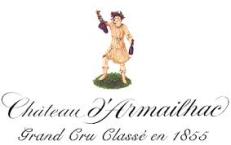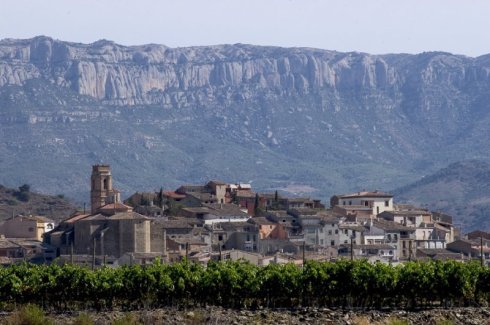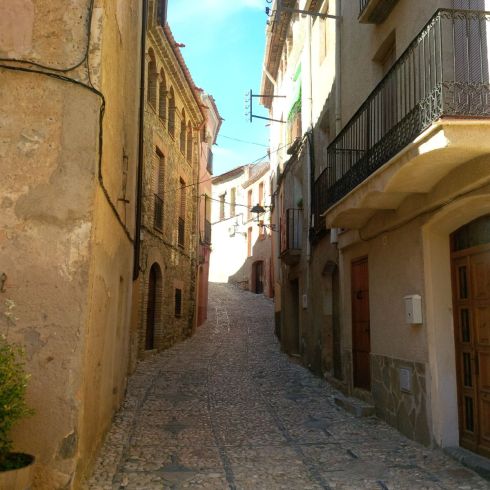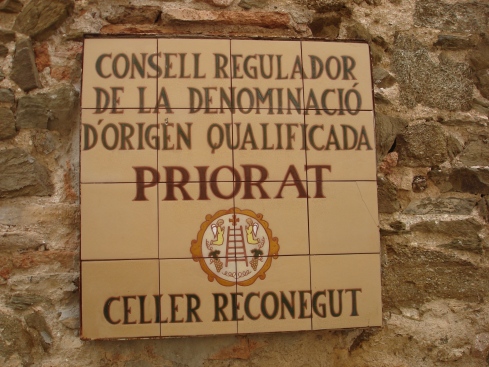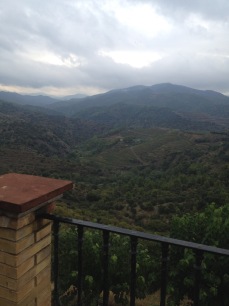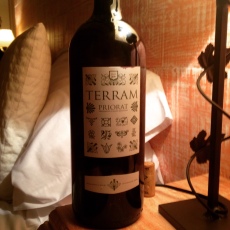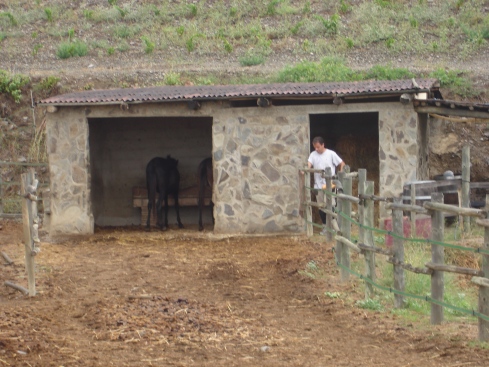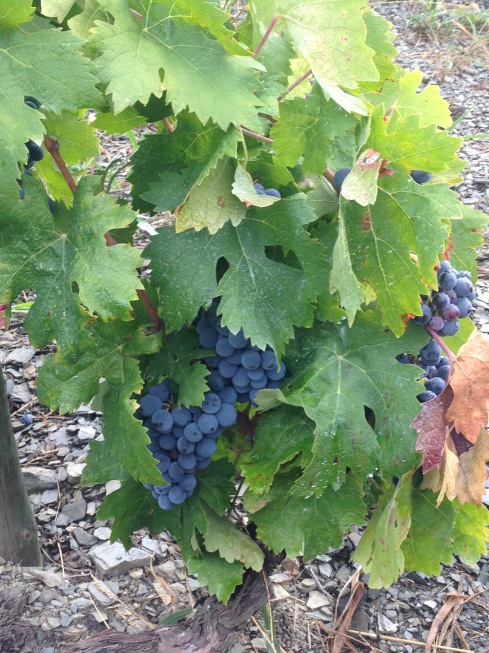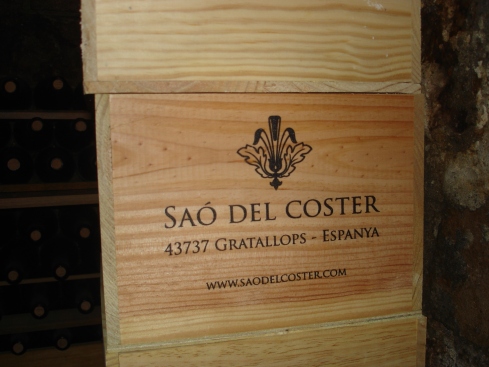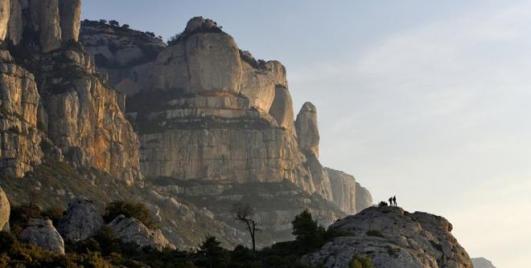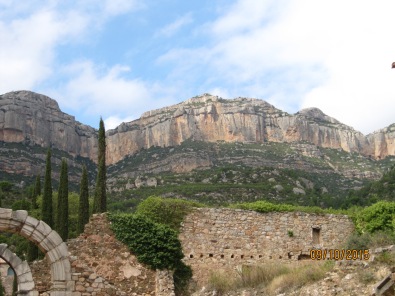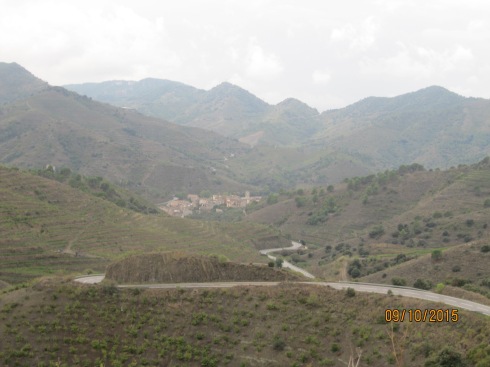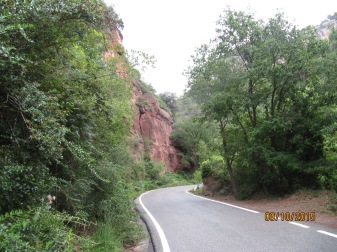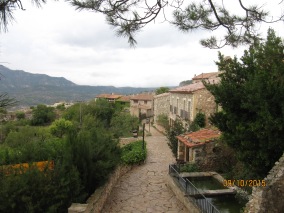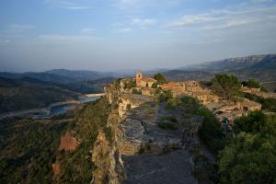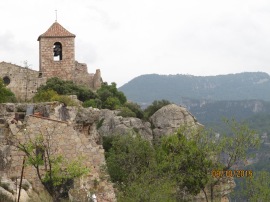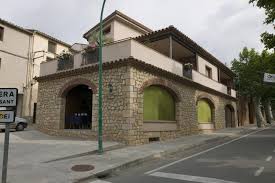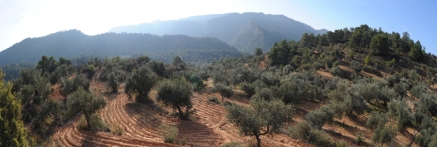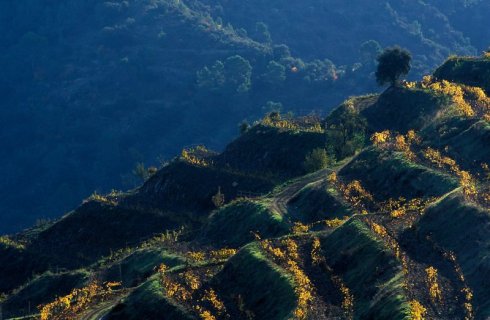“Where the hell is that?”, you ask. That is Priorat in Catalunya. And those terraces hold Garnatxa and Cariñena vines. It’s spectacular country! The DOQ Priorat (pronounced PRE – or – rat) is about 150 kilometres southwest of Barcelona. My BFF and I had the pleasure of spending 3 days there last month. This first post deals with our introduction to Priorat and hopefully provides you with a flavour of this special region.
Day 1: (circa 11:00 am) I maneuvered the balky rental out of Barcelona with my friend as navigator. Mood? Sky high anticipation and jet lagged after taking the red eye from Toronto. South through the environs of Barcelona, past Tarragona and Reus. About an hour and a half later, we arrived at the base of the town of Torroja. Pronounced To-ROY-ya in Spanish and To-ROW-je in Catalan.
You may think that places such as Torroja, Priorat, Montsant, Penedes, Barcelona, Girona, etc. are in Spain. You’d be wrong. They are in Catalunya.
Lesson #1: You will endear yourself to Catalans if you understand that they are not Spaniards – they are Catalans. When possible, using Catalan to communicate also is respectful and appreciated.
Back at Torroja, we sat in the car and pondered the question, “Where is our hotel, Cal Compte?” When you have no clue (BTW, we didn’t), you can sit in your idling car reviewing your travel file for only so long. Action is required. Ah, do we see potential help? Indeed, a stooped, old, weathered, darkly dressed woman with a cane was sitting at the regional bus stop. You can’t make this stuff up.
Now, this was the first of many occasions during my 2 and a half weeks in Spain that I wished that I had worked a bit harder with Hannah from fluencia.com. However, it may not have helped asking, “¿Donde esta Cal Compte?” when the woman spoke Catalan, not Spanish (Lesson #1).
It’s interesting that most of us tend to shout when communicating in a language that you know the other person DOES NOT UNDERSTAND. It’s as if through volume comes comprehension. But, in this case, we found that speaking loudly was of little use – the woman was functionally hearing impaired. That’s being polite. The woman was stone deaf! But, she graciously hobbled away waving her hand for us to follow her to a main floor garage off a nearby alleyway. Buddy was there working on farm implements and he pointed us towards our hotel, Cal Compte. This is when I learned that the narrow “alleyway” was actually the “street” to Cal Compte. “Are you shitting me?”
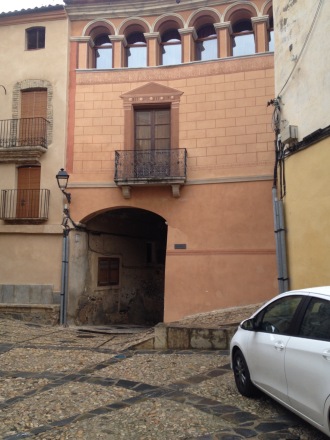
Passage to Cal Compte – Torroja
After some ‘Whoa, put the mirrors in’ and ‘Bill wait, you’re going to hit the……..O…O…O…OK, it’s alright now’ moments, we arrived at a town square, a plaça complete with church and stone fountain. And, just as Buddy said, Cal Compte was on our left. On a rising cobblestone street of stone and brick facades, Cal Compte was the building with the door slightly ajar. We peeked inside the door and quietly stepped down off the cobblestones into a large, dark, stone-walled two-story room. Seriously, are we in the right place? Where’s the concierge and valet parking?
“Hello? No answer. We pushed deeper into the next room, an equally large room furnished with a dining table. “Hello?” Then from the back of the building we heard, “William?” And out of the kitchen walked Graciela, our host. We were home indeed. We were shown to our rooms on the second floor; discovering the elevator only after lugging my so-close-to-overweight suitcase up the stairs.
Asked if we wanted to eat at Cal Compte that night, we said, “Si.” This wasn’t the last time on this trip that we agreed to a meal that we neither knew the cost of or the menu. Never a regret associated with any of them. In fact, opting to eat at Cal Compte blind was one of the best decisions we made all trip. My advice, trust. Trust: how else were we to experience Catalunya and Spain?
But, first things first. Where could we get lunch? It was past 1:00 pm and we hadn’t eaten since that forgettable in-flight wake up snack 6 hours ago. Graciela, and her main squeeze Vincente, suggested that we return to Porrera (which we’d passed on our way in to Torroja) to eat at a place called La Cooperativa.
We drove the 10 minutes back to Porrera, parked the car in Plaça Catalunya – a small, surprisingly busy plaça with the winery Sangenis i Vaqué at its head. We wandered into a store to ask directions to La Cooperativa. We were informed that La Cooperativa was, in fact, closed. After all, it was harvest time and all hands were required for wine. It was our first indication that there was winemakin’ goin’ on. I was getting pumped, stoked. And a bit thirsty.
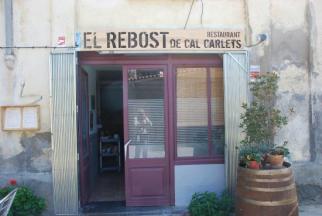
El Rebost de Cal Carlets
So, we chose El Rebost de Cal Carlets for lunch, nearby on the plaça. El Rebost (roughly translated – The Pantry) was very good. I had the bacallà a la crema d’avellana (cod in a hazelnut cream sauce) – huge tasty serving. And we split a litre of vi negre (red wine) that had started as una copa de vi – we are problem drinkers after all. I can’t describe the wine other than it was chilled a bit and very serviceable. Although I do distinctly remember the last few sips brought a, “This was pretty good.” Which is insightful wine critic stuff. Yeah?
Post meal, we wandered the town, bought a bottle of Porrera wine in a store on the plaça called Vinum Priorat (www.vinumpriorat.com). It has a very good selection of Priorat wines, olive oil, and other locally made products – tastings available.
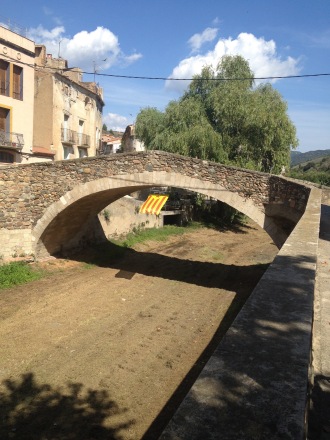
The Bridge to Vall Llach – Dry Riverbed – Catalan Flag Flying Proudly
Across the bridge from the plaça was the Celler Vall Llach in a renovated village house. Vall Llach is perhaps one of the more readily available and celebrated Priorat labels in North America. They produce more than 150,000 bottles annually from both DOQ Priorat and DO Monsant. The winery store and cellar were closed (you do need appointments here). Next time for sure.
I will feature individual Priorat wineries in subsequent posts but maybe it’s time for a general overview on Priorat wineries and tasting.
Despite being one of only two wine regions in Spain/Catalunya with the ‘qualified’ adjective (Rioja being the other), Priorat isn’t exactly what you might be used to as a ‘touring’ wine region. Fancy faux chateaus a la Napa? Nope. Wineries designed by Frank Gehry? Nosiree. Tasting rooms with paired nibbles? What? No! Wine clubs and library wines? Seriously? No! Tourist buses hogging the roads? Didn’t see a one all week. In fact, we saw perhaps 10 tourists aside from us in three days and that’s being generous.
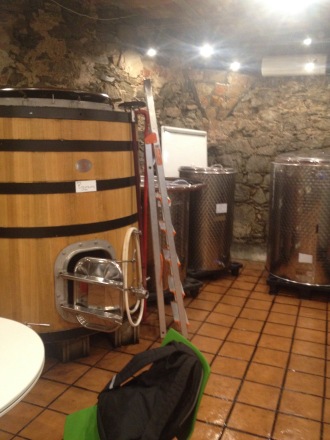
Sao de Coster “Tasting Room”
No, you taste wines By Appointment Only in what, in most cases, is the working winery. You interact amid the barrel room or press floor (which could be the same place) or in the vineyard directly with the employees, in particular the winemaker (enolog) in his or her boots and stained overalls. When you are in to wine and I am, it is simply an awesome way to understand what you are tasting, experiencing! It is so damn personal – as wine should be.
Now, there are a few large-scale wineries. Torres has a large high-tech winery that befits the multi-national wine company that is Torres, and Alvaro Palacios’s winery looks a bit Disney. But, in my limited experience, they are the exceptions. The bulk of the wineries are usually situated on small streets in one of the many villages or amid their vines in this rugged landscape.
Lesson #2: Enoturisme in Priorat is for real winos. But, it is growing. Let’s hope wineries and the people that work them can stay intimate, personal, and connected to tradition.
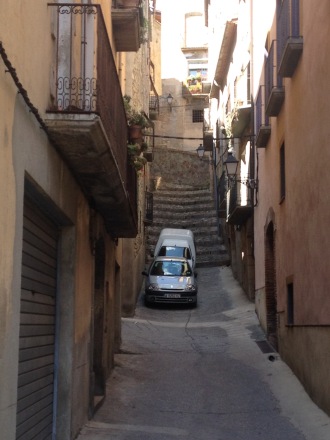
A ‘Street’ in Porrera – Garage Door on Left
Where was I? Oh yeah, walking the streets of Porrera. One highlight was a smallish garage that opened on a stainless steel tank and crates of grapes recently harvested – people busy hand sorting. Cool to watch for awhile and completely unexpected. But we were bushed and a bit buzzy. So we headed back down the winding road, up the alleyway to Cal Compte and a quick time-zone nap.
Back up by 6:00 pm, we popped the cork on the Clos Dominic Clos Petó 2010 (15€) that we had picked up at Vinum Priorat. This wine qualifies for Vi de la Vila certification. That means that the wine is made entirely from grapes from a single village – in this case, Porrera. It took us a sniff and a swish to remember how high in alcohol these wines can get. This one was 15% ABV – large in the glass, the mouth, and on the finish. Cariñena first, maybe Cabernet Sauvignon second, my guess. I’d say we should have decanted it. We drank a tumbler (or two?) on the second level terrace by our rooms and then headed down to the main floor terrace.
We had no sooner sat down when Vincente came out with some local olives (love olives), hazelnuts and almonds. He asked if we wanted some wine. Seriously? He opened a bottle of the house red. More on the house wine in a minute.
As we sipped and noshed, we could look out over the rooftops of the village on to the vined and olive treed terraced sides of the mountains. Poetic? It was so quiet. As my friend said, “You CAN NOT believe how quiet it is. No REALLY.” That’s how quiet it was!
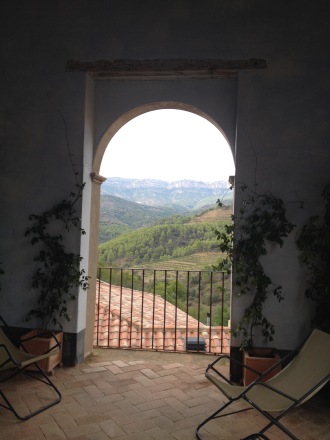
Terrace View Cal Compte – Montsant in the distance
I won’t go into too much detail on the meal – OK, I lie.
After the nuts and 0lives, we were started with a plate of thickly sliced aged sheep’s milk cheese with olive oil drizzled over and a bit of cracked black pepper on top with fresh bread on the side. I had seen the loaves covered with towels rising in the kitchen that afternoon. What an easy plate. Simple and evocative.
Lesson #3: Drizzle good olive oil on everything. FYI, Priorat produces a lot of olive oil for a small region most of it under the Denominació d’Origen Protegida “Siurana” or Protected Designation of Origin Siurana. We visit an olive oil mill tomorrow. Stay tuned.
Then followed a bowl of the house made gazpacho with fresh diced tomatoes, cukes, and croutons on the side to add. Verrry nice. So incredibly fresh.
Following that we were served a green salad with perfectly ripe small tomatoes and a slab of fried goat cheese on top, drizzled with olive oil. No salt and pepper needed to get those tomàquets to release their flavour.
Then a plate of beef sliced thinly and lightly seared – almost carpaccio style – with olive oil and some fresh herbs. Melt in your mouth beef. Dessert? Poached pears with house made hazelnut ice cream. And to finish off the evening, a small glass of locally produced dessert wine – dolç, I believe it’s called. It had nice body and an herbal finish. But, I think it’s an acquired taste. How much did this meal cost? We had no idea.

Pedrablava 2012 – And it is Empty!
The house wine was PedraBlava 2012 and according to the label and Vincente, it was made expressly for Cal Compte by Clos Mogador, arguably the most renowned winery in Priorat. The first wine we had (Clos Dominic), although chronologically older was expressing it’s youth, edgy, unsettled but showing potential – needed time. This wine was drinking well right then with enough backbone, fruit, and spirit to age for awhile too. It may have simply been the difference between sipping sans food and sipping with a delicious meal. But, I preferred the Pedrablava. I couldn’t find the blend for the Pedrablava but I’m betting some non-traditional grapes made their way into it – Syrah maybe – a spicy finish? And like most of the Priorat reds we tasted, high in alcohol – 16%. Now, if we had thought about wine as a beverage containing serious alcohol before we started, we might have foregone the full litre at 3:00 pm given that this stuff is indeed large………….No, …………you know I’m just kidding. We would always chose to ignore that fact. If you have to think that hard about wine, you don’t deserve it.
Lesson #4: Priorat reds are generally high in alcohol.
Lesson #5: Pay no attention to Lesson #4. Priorat reds are large, expressive statements about this peaceful region. The power of the slate, the terraced slopes, the traditions, the labour intensity and passion required is reflected in the mass and grip of the wine. Enjoy them!
We slept soundly. Did I say it was quiet? Well, all except the church bells.
If your interest is peaked, my planning resources were:
http://www.turismepriorat.org
http://www.vinologue.net
http://www.catalunyawine.com
Next Post: Siurana, Cordunella de Montsant, Laura, Escaladei, another Cal Compte meal, and lots more on Priorat wine
Tags: Cal Compte, Clos Dominic, Clos Mogador, El Rebost de Cal Carlets, Porrera, Priorat, Torroja del Priorat, Vall Llach, www.catalunyawine.com, www.turismepriorat.org, www.vinologue.net
 I’d say that I have recommended the Château Saint-Roch Chimères maybe five or six times over the years. The 2013 vintage #119354 $19.95 is like the ones preceding it. Only better. It is a healthy, round blend of primarily Grenache and Syrah. It’s a Côtes du Roussillon that smooths out some of the rough edges that you might see with these wines. It is a beaut. Cherries, spicy (Syrah), earthy – Love it! It would be perfect with some kind of roast dinner in this fall season.
I’d say that I have recommended the Château Saint-Roch Chimères maybe five or six times over the years. The 2013 vintage #119354 $19.95 is like the ones preceding it. Only better. It is a healthy, round blend of primarily Grenache and Syrah. It’s a Côtes du Roussillon that smooths out some of the rough edges that you might see with these wines. It is a beaut. Cherries, spicy (Syrah), earthy – Love it! It would be perfect with some kind of roast dinner in this fall season. Another great red from the south of France is the 2013 Famille Perrin Vinsobres Les Cornuds #566854 $17.95. This is from the Perrin….famille. They are the family that creates Château de Beaucastel, an iconic wine from Châteauneuf-du-Pape. These guys do know wine. This is a very gentle but medium-bodied handful of cherries with a bite. I’m thinking if it’s cherries then a cherry match – Muscovy duck breast, pork tenderloin or something else like that. This is from a village in the Côtes du Rhone that warrants villages designation. Top drawer.
Another great red from the south of France is the 2013 Famille Perrin Vinsobres Les Cornuds #566854 $17.95. This is from the Perrin….famille. They are the family that creates Château de Beaucastel, an iconic wine from Châteauneuf-du-Pape. These guys do know wine. This is a very gentle but medium-bodied handful of cherries with a bite. I’m thinking if it’s cherries then a cherry match – Muscovy duck breast, pork tenderloin or something else like that. This is from a village in the Côtes du Rhone that warrants villages designation. Top drawer.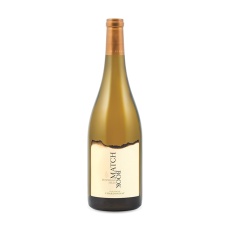 If you’ve been reading these pages, you know that The Director does love her Chardonnay. And, contrary to current trends, she likes it oaked. The past few weeks, we’ve been enjoying the 2013 Dunigan Hills Match Book #205492 $20.95. This is oaked but not that much. It allows the typical apple scents and flavours through without adding any tropical fruit stuff. Vanilla on the finish but, need I say, not too much. It’s a Goldilocks Chardonnay – Just Right.
If you’ve been reading these pages, you know that The Director does love her Chardonnay. And, contrary to current trends, she likes it oaked. The past few weeks, we’ve been enjoying the 2013 Dunigan Hills Match Book #205492 $20.95. This is oaked but not that much. It allows the typical apple scents and flavours through without adding any tropical fruit stuff. Vanilla on the finish but, need I say, not too much. It’s a Goldilocks Chardonnay – Just Right. I’ve spoken of my love for wines from Washington State – Columbia Crest, Chateau Ste. Michelle, Mark Ryan and my fave Andrew Will. Love the Will! And, I have written about the quirky, inventive, yet delicious wines from Charles Smith. We have been grabbing a Chardonnay from the – gasp – General Listing aisles. I know. It’s unimaginable that yours truly would linger with the plebes but I am not a snob (he says, with tongue firmly planted in cheek). In any event, Charles Smith has a great chard – 2013 Charles & Charles Chardonnay #394734 $15.95. This is a mid-weight, slightly oaked white with a bit more vanilla than the one above. It’s a keeper. A perfect sipper without food after a long day writing about wine, hanging at your local pub, watching the Blue Jays lose in six. Yes, that means we’ve had a bunch of it. And, it’s a Stelvin twist cap meaning that you can actually open this as a third bottle of the night without incurring cuts and stabs.
I’ve spoken of my love for wines from Washington State – Columbia Crest, Chateau Ste. Michelle, Mark Ryan and my fave Andrew Will. Love the Will! And, I have written about the quirky, inventive, yet delicious wines from Charles Smith. We have been grabbing a Chardonnay from the – gasp – General Listing aisles. I know. It’s unimaginable that yours truly would linger with the plebes but I am not a snob (he says, with tongue firmly planted in cheek). In any event, Charles Smith has a great chard – 2013 Charles & Charles Chardonnay #394734 $15.95. This is a mid-weight, slightly oaked white with a bit more vanilla than the one above. It’s a keeper. A perfect sipper without food after a long day writing about wine, hanging at your local pub, watching the Blue Jays lose in six. Yes, that means we’ve had a bunch of it. And, it’s a Stelvin twist cap meaning that you can actually open this as a third bottle of the night without incurring cuts and stabs.



